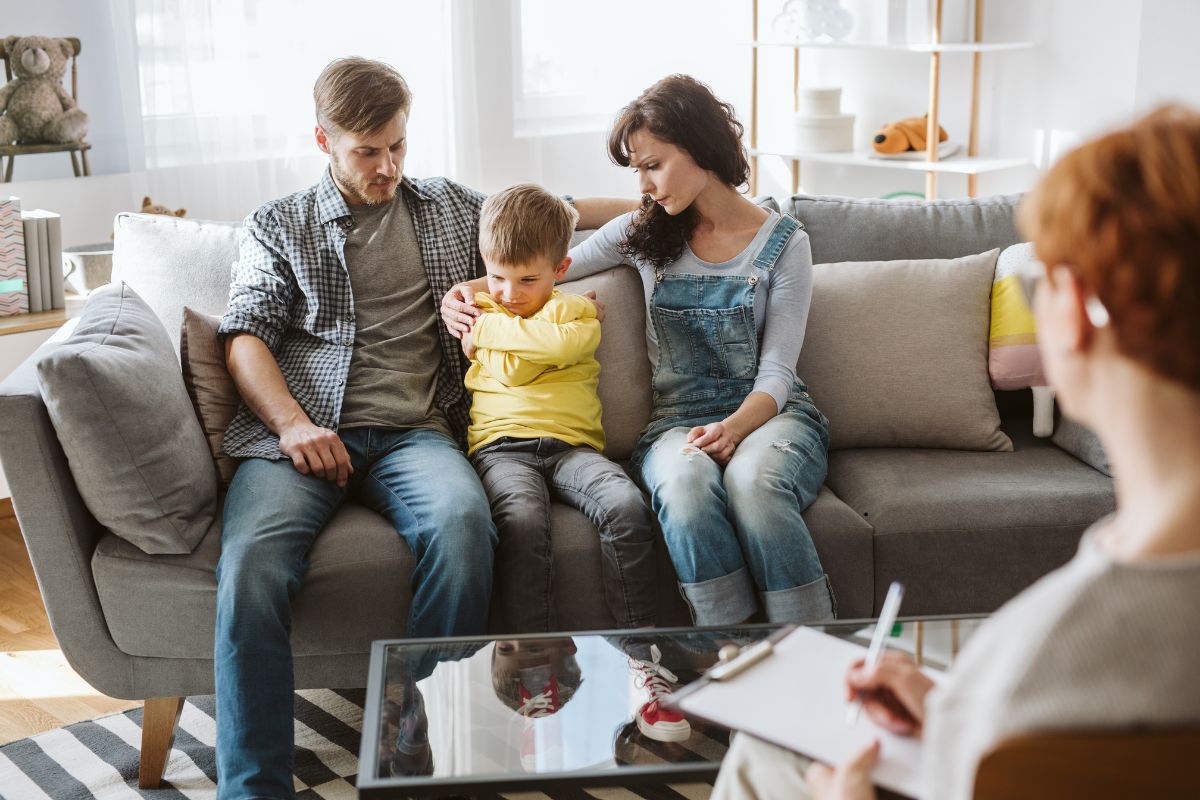How Does Reunification Therapy Help Families Heal?
Reunification therapy is a structured therapeutic process designed to rebuild parent-child relationships after separation, divorce, or estrangement. Led by licensed mental health professionals, this therapy creates a safe, neutral environment where families can restore communication, rebuild trust, and heal emotional wounds caused by conflict or extended separation.
What Reunification Therapy Does:
- Restores parent-child bonds damaged by custody disputes or family conflict
- Provides structured healing through individual and joint therapy sessions
- Addresses parental alienation when children have been influenced to reject a parent
- Creates emotional safety for children to express feelings without judgment
- Supports long-term family stability beyond the immediate crisis
When Reunification Therapy Is Used:
- Court-ordered situations during custody battles or visitation disputes
- Voluntary family healing when parents recognize relationship damage
- Post-divorce recovery to help children reconnect with both parents
- Parental alienation cases where children refuse contact with one parent
- After extended separation due to legal, medical, or personal circumstances
How the Process Works:
- Assessment phase – Individual meetings to understand family dynamics
- Structured activities – Low-pressure interactions to build comfort
- Joint sessions – Guided communication between parent and child
- Therapeutic techniques – Age-appropriate methods like play therapy, CBT, or creative expression
- Progress monitoring – Regular evaluation and court reporting if mandated
Key Success Factors:
✓ Child’s emotional readiness and willingness to participate
✓ Parent accountability and openness to change
✓ Trauma-informed approach that prioritizes child safety
✓ Realistic timeline allowing healing to occur naturally
✓ Professional expertise in family trauma and reunification
Important considerations: Reunification therapy is not appropriate in cases involving unresolved abuse, severe trauma, or when children aren’t emotionally ready. Success depends on genuine commitment from both parent and child, with the child’s safety and emotional well-being as the top priority.

Understanding Reunification Therapy and How It Helps Families Reconnect
Reunification therapy is a structured process designed to help rebuild the relationship between a parent and child after a period of separation, conflict, or estrangement. It offers a safe, neutral environment guided by a licensed mental health professional. The therapy focuses on improving communication, rebuilding trust, and fostering emotional connection. Often, it is recommended by the court during custody battles, or it may be initiated voluntarily by a parent who wants to reconnect with their child.
Children may experience emotional distress after a family separation. They may feel hurt, confused, angry, or even betrayed. These emotions can create distance between the child and one or both parents. Reunification therapy allows both parties to process these feelings in a healthy, supportive way. It works by creating a framework where both the parent and child feel emotionally secure and heard.
Therapy may include individual and joint sessions. In individual sessions, the therapist helps each person express their thoughts without fear of judgment. In joint sessions, the parent and child work on rebuilding their bond. Activities might include structured conversations, therapeutic games, or exercises designed to improve emotional understanding. Techniques such as talk therapy, play therapy, and creative expression are chosen based on the child’s age and developmental needs. Therapists often use approaches like:
- Cognitive Behavioral Therapy (CBT) to address negative thought patterns.
- Narrative Therapy to help the child and parent reshape their personal stories.
- Family Systems Therapy to examine how family dynamics impact relationships.
Each technique is adapted to fit the unique emotional background of the family. The ultimate goal is not to force reconciliation but to open the door for healing, if and when the child is emotionally ready.
How to Prepare for Reunification Therapy
Starting therapy can feel overwhelming, especially when past pain or conflict is involved. Preparation can ease this transition and improve the overall outcome. Parents can take several important steps to set the stage for a positive experience:
- Recognize past difficulties without placing blame.
- Maintain realistic expectations. Rebuilding trust takes time.
- Avoid promising results. Let the child know that healing is a process.
- Create emotional safety. Listen to your child’s feelings without judgment.
Before the first session, it’s helpful to explain to your child what therapy involves. Emphasize that it is a safe place where they can speak freely and be heard. Let them know they are not alone in the process and that they have the right to share their emotions at their own pace.
What Happens in the First Month of Therapy
The first month of reunification therapy focuses on assessment, building comfort, and laying the foundation for future work. Each session has a specific purpose and gradually builds momentum:
- Session 1: The therapist meets with each participant separately to learn about the background and understand individual goals.
- Session 2–3: The parent and child engage in low-pressure, structured activities to build emotional safety.
- Session 4 and beyond: The therapist guides deeper emotional exploration and encourages honest communication.
Families may be assigned “homework” between sessions. These tasks might include writing letters to each other, practicing positive communication, or reflecting on feelings through journaling or drawing. These activities help keep the progress moving between sessions and reinforce new emotional habits.
The Therapist’s Role in Reunification
The therapist plays a central role in managing the emotional dynamics of reunification. Their main responsibility is to ensure emotional safety while promoting healthy interaction. A skilled therapist will:
- Encourage respectful communication between parent and child.
- Protect the emotional well-being of the child at all times.
- Educate parents on child development and how trauma affects behavior.
- Stay neutral, without aligning with either parent.
- Report progress to the court, if the therapy is court-ordered.
In some cases, the therapist may recommend additional support, such as parenting classes or individual therapy. These services can help address deeper issues and improve long-term outcomes.
It is important to understand that the therapist does not “fix” the relationship. They create an opportunity for the child and parent to connect, if the conditions feel emotionally safe and appropriate for that to happen.
Common Challenges Families May Face
Reunification therapy isn’t always smooth. Many families encounter emotional hurdles that must be addressed carefully. Common obstacles include:
- Attachment imbalance: The child may feel more secure with one parent.
- Negative conditioning: One parent may have influenced the child’s perception of the other.
- Unresolved trauma: The child may carry emotional pain from past events.
- Legal stress: Ongoing custody disputes may increase anxiety and resistance.
Therapists help navigate these issues by reinforcing emotional boundaries, encouraging empathy, and addressing harmful dynamics with care. While setbacks are common, consistent effort and patience can lead to meaningful change over time.
Concerns About Reunification Therapy
Though the intention behind reunification therapy is positive, it’s not always beneficial for every situation. There are real concerns when therapy is used without considering the emotional readiness of the child. Red flags include:
- Court-mandated therapy that the child doesn’t feel ready for.
- A history of abuse that hasn’t been fully addressed.
- Dismissal of the child’s concerns, leading to further emotional harm.
Children may resist reconnection for valid reasons. Past emotional neglect, manipulation, or fear for their safety are not to be ignored. In these cases, reunification therapy must be approached with extreme sensitivity. The child’s voice must be heard, respected, and protected at all times.
How Parents Can Support Their Child in the Process
Parents can play a crucial role in making reunification therapy more effective. By showing empathy and patience, they can ease the emotional load on their child. Here are some key ways to support your child:
- Validate emotions: Let your child know it’s okay to feel scared or angry.
- Be patient: Don’t rush the healing process.
- Avoid guilt tactics: Don’t say things like “you’re hurting me.”
- Respect their boundaries: Give them space if they pull back.
- Support healthy expression: Encourage journaling, drawing, or one-on-one therapy.
When children feel heard and respected, they are more likely to engage with therapy. Emotional safety—not pressure—is what drives real progress.
Reunification therapy offers hope for healing, but only when handled with care, respect, and a child-centered approach. By staying patient, open, and compassionate, families can begin to rebuild trust and move toward stronger relationships.

How Families Begin Reunification Therapy
Reunification therapy starts in one of two ways: voluntarily or by court order. Each path has its own structure, but both aim to help repair broken parent-child relationships through professional support and emotional care.
Voluntary therapy is initiated by a parent or guardian who recognizes a disconnect with their child and wants to restore the bond. It typically begins with mutual agreement on goals and expectations. The process is flexible, adjusting to the family’s emotional readiness and pace. Families can set their own milestones, and sessions are guided more by therapeutic need than by legal timelines.
Court-ordered therapy is mandated during custody or visitation disputes. This approach may come with more structure, including strict attendance rules and progress reports to the court. The therapist may be required to submit updates outlining the child’s emotional response and the family’s efforts. In these cases, therapy becomes part of a legal process, but emotional safety must still remain the top priority.
No matter how therapy begins, its success depends on three factors: emotional safety for the child, mutual willingness from both parent and child, and the support of a skilled, neutral therapist.
How Therapy Addresses Parental Alienation
Parental alienation happens when a child is influenced—either directly or indirectly—to reject the other parent. This can develop gradually through negative talk or emotional manipulation. Reunification therapy can help address this situation, but only when handled with care and a focus on the child’s emotional well-being.
Therapists work to reverse alienation by:
- Exploring the child’s feelings to understand the root of the rejection
- Educating both parents about how alienation damages the parent-child bond
- Building trust gradually, with the child’s permission and pace
In more severe cases, therapists may include:
- Parenting coordination services to improve cooperation
- Co-parenting communication training to reduce conflict
- Individual therapy for each parent to address harmful patterns
It’s important to understand that therapy should never force a child to reconnect by ignoring trauma. Reunification must always prioritize the child’s emotional safety and consent.
Where Reunification Therapy Happens
The location of therapy plays a major role in its success. Children who feel nervous or emotionally vulnerable may respond better in spaces designed to reduce pressure and fear.
Common settings include:
- Private therapy offices: These are often used in voluntary cases and offer a calm, confidential environment.
- Neutral, child-friendly spaces: These reduce anxiety and create comfort through toys, art supplies, or calming decor.
- Court-supervised facilities: Used in high-conflict or safety-sensitive situations, these locations provide professional oversight.
- Home visits: Rare, and only approved when the therapist is confident it will support progress and not increase stress.
Therapists choose locations that encourage openness, comfort, and a balanced power dynamic between the parent and child.
Why Individual Counseling Supports Reunification
In addition to joint therapy, individual sessions give each family member a safe place to work through personal emotions. This parallel support can help participants feel more prepared for reunification efforts.
For children, individual therapy offers:
- Tools for managing anxiety, anger, or sadness
- A safe space to explore feelings without pressure
- Practice expressing emotions and setting boundaries
For parents, individual therapy can help:
- Learn co-parenting and communication skills
- Process grief, guilt, or frustration
- Prepare emotionally for joint sessions with the child
Together, individual and joint therapy create a foundation for long-term healing and more stable relationships.
Why Courts Mandate Reunification Therapy
Family courts may order reunification therapy for several reasons. Often, it’s a response to visible breakdowns in parent-child relationships or signs of emotional distress in the child.
Common triggers include:
- Estrangement: When one parent is excluded for an extended time
- Visitation interference: When parenting time is denied or disrupted
- Violation of agreements: Noncompliance with court-approved custody plans
- Child behavior concerns: Emotional or behavioral signs linked to family conflict
The court expects therapy to:
- Restore regular contact between child and parent
- Address emotional harm caused by separation or conflict
- Monitor how the child is emotionally affected over time
If therapy causes further harm or fails to improve the relationship, the court may consider new custody or visitation arrangements.
When Reunification Therapy Is the Right Fit
Not every situation is appropriate for reunification therapy. It works best when the environment is emotionally safe and everyone involved is willing to participate openly.
Reunification therapy is most effective when:
- The child feels secure and not pressured
- The parent takes responsibility and is open to change
- Both parties are willing to engage in the process
- The therapist is experienced in trauma-informed family work
It may not be a good fit if:
- There is current or unresolved abuse
- The child has PTSD or trauma symptoms related to the parent
- Therapy is used to override protective services or minimize serious concerns
In these situations, reunification therapy may do more harm than good. Alternatives should be explored with child safety as the top priority.
Checklist for Choosing Reunification Therapy
When approached thoughtfully, reunification therapy can offer families a meaningful path toward healing. It’s not a quick fix. It takes time, patience, and emotional effort. The goal isn’t to force closeness, but to allow connection to grow naturally, with professional guidance.
Here’s a checklist to help parents decide if therapy is the right step:
- Is your child emotionally safe with the other parent?
- Are both parties willing to participate with an open mind?
- Is your therapist trained in family trauma and reunification?
- Are you ready to follow the child’s emotional pace?
If you answered “yes” to most of these, reunification therapy may offer your family a chance to reconnect in a healthy, supported way. Always remember—success is not about forcing a perfect relationship, but creating space for healing, growth, and emotional safety.

Supporting Children Through Reunification: What Parents Can Do to Help
Parents play a critical role in reunification therapy. How they support their child emotionally—both in and out of sessions—can make or break the healing process. Children need to feel safe, heard, and respected. With the right approach, parents can help their children feel more secure and open during this challenging time.
Help Your Child Feel Heard and Understood
One of the most important things you can do is listen—really listen. Instead of rushing to explain or fix, give your child space to share their feelings. They may express fear, sadness, anger, or confusion. Your job is to hear them out without judgment, even if you disagree with what they say.
Use phrases like:
- “It’s okay to feel that way.”
- “Thank you for telling me how you feel.”
- “I’m here to listen whenever you’re ready.”
Children are more likely to engage in therapy when they know their feelings matter. Feeling seen builds trust, which is essential for progress.
Work on Yourself as a Parent
It’s common for parents to carry emotional baggage from the separation or custody conflict. These emotions—like guilt, resentment, or grief—can affect how you respond to your child. That’s why individual therapy is often recommended for parents as well.
A therapist can help you:
- Process your own emotional pain
- Develop healthier coping strategies
- Improve communication and parenting skills
Working on yourself not only benefits your child—it strengthens your ability to support the reunification process. When parents model emotional growth, children feel safer doing the same.
Build Trust Outside of Therapy
What happens outside the therapy room is just as important as what happens inside. Rebuilding a damaged relationship takes consistent, thoughtful effort. Keep your promises and show up when you say you will. Even small actions, like a shared snack or a kind note, can rebuild emotional bridges.
Avoid saying negative things about the other parent. Even subtle comments can confuse or hurt your child. They may feel torn between parents or forced to choose sides, which damages trust.
Consistency, kindness, and patience matter more than grand gestures. Trust is built over time with steady, respectful behavior.
Respect Your Child’s Boundaries
Not every child is ready to reconnect right away. Some may need more time or space. Pressuring your child to hug you, talk about the past, or say “I love you” can make them shut down. Let the therapist guide when and how deeper conversations happen.
Give your child emotional space while remaining present and supportive. Reunification is not about rushing to recreate the past—it’s about carefully building a future of healthy interaction.
Know When Therapy Might Not Be the Right Choice
Reunification therapy isn’t always appropriate. In situations involving abuse, neglect, or intense emotional manipulation, this approach can cause more harm than healing. In such cases, the courts may recommend alternatives like supervised visitation or, in rare situations, the termination of parental rights.
Therapy may also be delayed if a parent is struggling with untreated mental health issues or substance use. These underlying problems must be addressed first to ensure the child’s emotional safety.
Explore Alternative Support Options
Sometimes, reunification therapy isn’t the best fit—but that doesn’t mean support has to stop. Other types of therapy can still help families move toward healing.
- Family therapy: Focuses on improving communication between all members, not just one parent and child. It addresses the entire family system and encourages mutual understanding.
- Online therapy: Platforms allow teens and parents to connect with licensed therapists. It offers privacy and convenience, especially for families dealing with long-distance separation or busy schedules.
Keep in mind that while online therapy can be useful, it is generally not accepted as a formal legal alternative in court-ordered cases. Still, it can prepare families emotionally before beginning in-person reunification.
Support Long-Term Healing
Reunification therapy is just one part of a much larger journey. Even after therapy ends, families need to keep working on their relationships. Ongoing communication, regular emotional check-ins, and occasional follow-up therapy sessions can help prevent future breakdowns.
Healing doesn’t always mean returning to how things were. In some cases, reunification may not fully repair the relationship—but it can still offer closure, understanding, and a path forward. What matters most is that the child feels emotionally safe and has the opportunity to heal in a supportive environment.
Key Takeaways for Parents:
- Listen with patience and without judgment
- Invest in your own healing to better support your child
- Rebuild trust through consistent, respectful behavior
- Respect your child’s pace and emotional boundaries
- Explore alternatives if reunification therapy isn’t a good fit
- Continue nurturing the relationship even after therapy ends
Ultimately, the goal isn’t just to reconnect—but to create a relationship that is healthier, safer, and grounded in mutual respect. When children feel supported and protected, they are more likely to open up, heal, and rebuild meaningful connections with the parent they’ve become estranged from.
Conclusion
Reunification therapy offers a structured, compassionate path to healing fractured parent-child relationships. It prioritizes emotional safety, not forced reconciliation, ensuring children feel heard and respected throughout the process. Whether initiated voluntarily or mandated by the court, the success of therapy depends on patience, readiness, and the guidance of a trauma-informed professional. Parents must commit to deep listening, emotional growth, and respectful boundaries. When approached with care and sincerity, reunification therapy can lay the foundation for renewed trust, long-term healing, and stronger family bonds. It’s not about restoring the past—it’s about building a healthier, more secure future where every family member feels valued.
Frequently Asked Questions (FAQs)
What is reunification therapy and when is it used?
Reunification therapy helps rebuild a relationship between a parent and child after separation or estrangement. It’s used during or after custody conflicts, especially when emotional distance or rejection has formed.
How does a therapist support the child during therapy?
The therapist ensures the child feels emotionally safe and heard. They guide healing with age-appropriate techniques like talk, play, or art therapy.
Can reunification therapy be harmful in some situations?
Yes, if there’s unresolved trauma, abuse, or if the child isn’t emotionally ready. Therapy must never override a child’s safety or boundaries.
What should parents avoid during the reunification process?
Parents should avoid blaming, guilt-tripping, or rushing the child. Emotional pressure can damage trust and hinder progress in therapy.
How long does reunification therapy usually take?
There’s no fixed timeline. It depends on the child’s emotional readiness, the family’s history, and consistency in attending and applying therapeutic practices.

